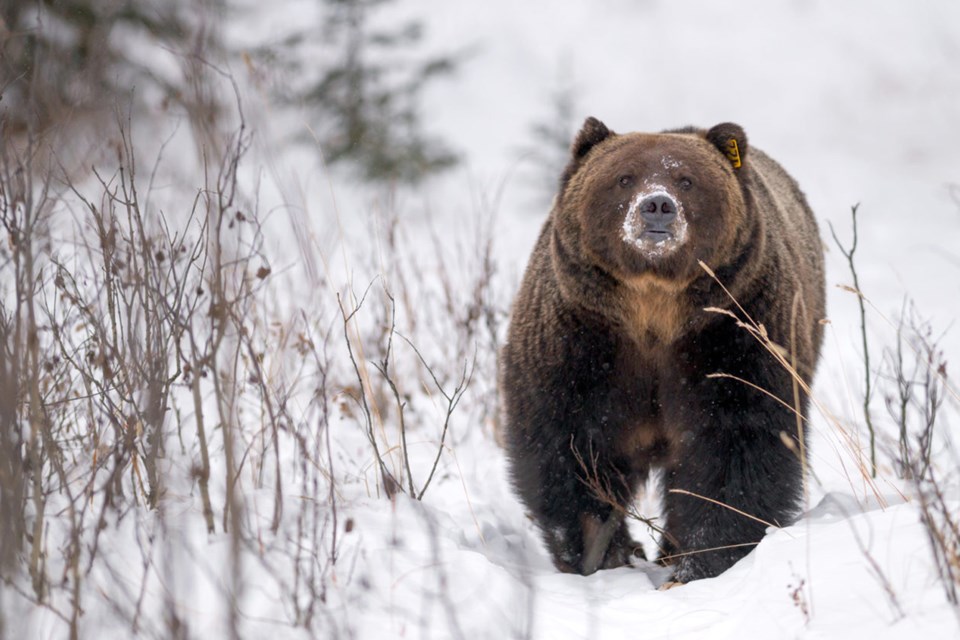BANFF – The Boss is back.
The first bear sighting in Banff National Park was reported by a member of the public on March 14 west of the Banff townsite and Parks Canada officials presume it’s No. 122, the so-called patriarch of Banff National Park grizzly bears known as The Boss.
“We haven’t confirmed whether it’s 122 or not, but we suspect it is,” said Blair Fyten, a human-wildlife management specialist for Banff National Park.
“He generally comes out this time of year and hangs out in the same area between Lake Louise and Banff. It’s his usual habit.”
Typically, bear 122 travels up and down the train tracks when he first comes out of the den each spring, where he searches for spilled grain or the remains of other wildlife that were struck and killed by trains over winter.
Food is scarce when bears emerge from hibernation in mid to late March to mid-May, particularly where snow lingers at higher elevations.
Lean and in need of nutrition, bears typically spend spring searching for food in the valley bottoms and don’t move to higher elevations until the snow disappears and vegetation greens up later in the season.
“There’s not a lot of food out there so they’re scavenging on whatever they can find – maybe an animal that was hit by the train and died off in the trees over winter or they’re eating grain along the tracks,” said Fyten.
“We still get a little bit of spilled grain… not as much as we used to, but it’s still an attractant.”
Bear 122 has been known to chase wolves off a kill to get a protein-rich feed early season.
“Maybe he’s competing with wolves,” said Fyten. “If wolves take something down, maybe he chases them off and takes over that carcass. That’s just his usual pattern.”
Last year, The Boss was first spotted out of his den on March 29. In 2020, a Parks Canada resource conservation officer came across large bear tracks on Feb. 28 – the earliest a grizzly bear had been recorded out of the den in Banff over the previous decade.
A remote camera picked up The Boss on March 19, 2019. In 2018, he was spotted March 24. In 2017, there was a confirmed sighting of No. 122 on March 22, in 2016 on March 5, in 2015 March 19 and in 2014 on March 16.
With bears emerging, wildlife experts say it’s time for residents and visitors to brush up on their safety awareness, including carrying bear spray, having it easily accessible, knowing how to use it and ensuring it has not expired.
“At this time of year, people are still cross-country skiing and snowshoeing and generally when you’re out doing snow sports you don’t expect to run into a bear,” said Fyten.
“But there’s a likelihood you could, so you should be getting bear spray out of the closet if you haven’t been carrying it all winter, dust it off and check that it is not expired and is still functioning.”
Making noise and travelling in groups is also highly recommended. Keeping dogs on a leash and under control at all times is mandatory in the park.
“When you’re out on the landscape it’s good to make a lot of noise and watch for signs and tracks in the snow. You don’t want to startle a bear and have a surprise encounter,” said Fyten.
“If you are out recreating with dogs, ensure they’re on a leash. Sometimes, if dogs aren’t on leashes, they can run off and might bring the bear back right towards you.”
Fyten also reminds residents and visitors to immediately leave an area if they see a dead animal or smell something rotten.
“Leave the area as quick as you can because there’s a good chance a carnivore might be on that carcass,” he said. “And please report it to dispatch.”
Large male bears are typically the first out of their dens, followed by female bears without offspring.
Following that, females with older offspring will come out of their dens; then females with young-of-year cubs will be the last to emerge, sometimes into late May or early June.
Fyten said it’s hopeful some of the area’s female grizzly bears have newborn cubs.
“There’s potentially one or two of the female grizzly bears in the area that might pop out with cubs,” he said.
People are always excited to get out to see bears and wolves in spring, but Parks Canada urges photographers to give wildlife plenty of space.
“We ask people stay a minimum of 100 metres and not follow or pursue to get the perfect picture,” said Fyten, asking photographers to take a photo and quickly move on.
“Bears are stressed at this time of year, looking for food, and if we’re stressing them more and causing them to move away from us, they don’t need that.”
There are currently an estimated 65 grizzly bears in Banff National Park. Many of these bears, however, do not spend their entire lives within the park.
Grizzly bears are considered a threatened species in Alberta.




